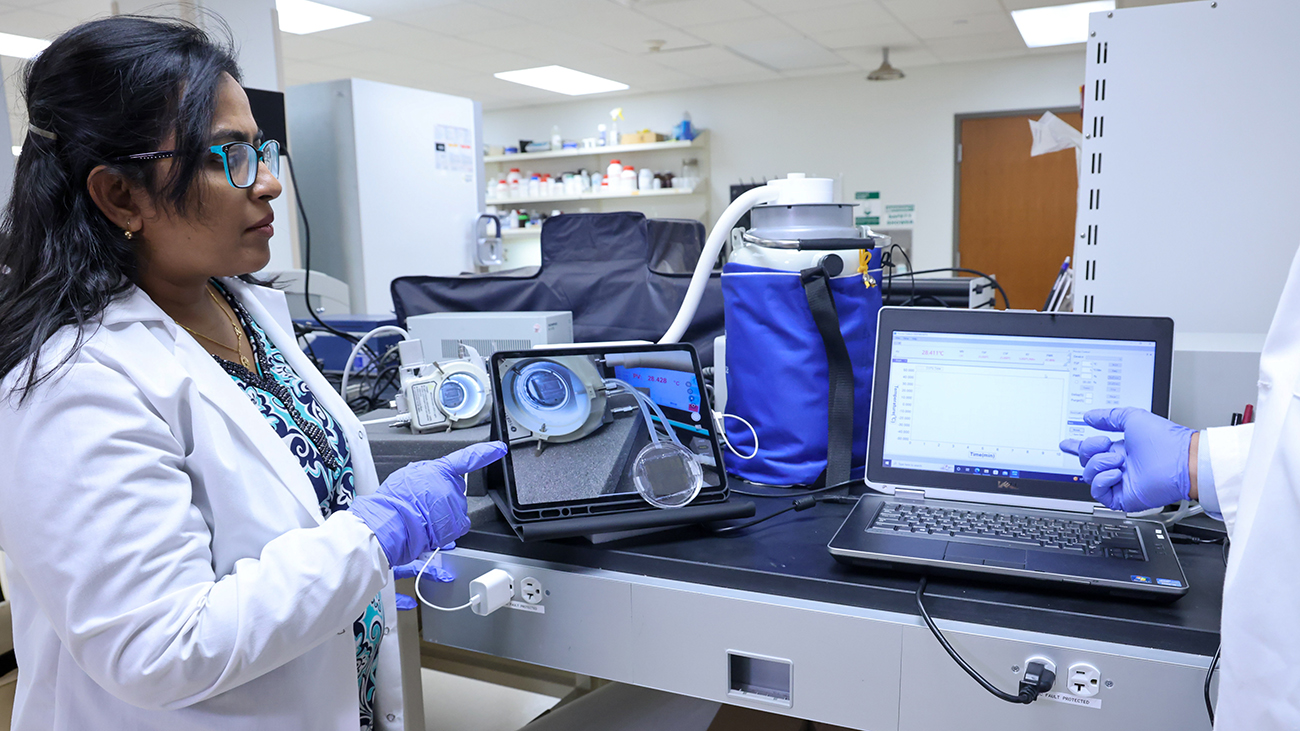- Featured
- Research
- Science
- Technology
- Engineering
WT Awarded Department of Energy Grant to Further Study of Cloud Formation
Copy by Chip Chandler, 806-651-2124, cchandler@wtamu.edu
CANYON, Texas — Ongoing research conducted by a West Texas A&M University team into how climate change can be measured recently won a $150,000 grant from the U.S. Department of Energy.
The grant will fund the joint research of Dr. Naruki Hiranuma, associate professor of environmental science; Dr. Swastika Bithi, assistant professor of engineering; and Dr. Sanjoy Bhattacharia, assistant professor of mechanical engineering. Bithi and Bhattacharia are part of WT’s College of Engineering , and Hiranuma is a faculty member in the Paul Engler College of Agriculture and Natural Sciences .
Hiranuma and his team of student researchers have been studying aerosols in ice-containing clouds. Aerosols, or ice-nucleating particles, are the microscopic material in the air that water vapor condenses around to form ice crystals that make up clouds. Those particles can increase precipitation and deplete clouds, and studying them is especially important in the Arctic, where accelerated warming is occurring.
Their research has involved the deployment of a remote-controlled atmospheric simulation, or a Portable Ice Nucleation Experiment, chamber in Alaska, the Azores and in Northeast Oklahoma. WT is the first university in the world to have purchased and deployed a PINE system.

Photo: This close-up view of Dr. Swastika Bithi's microfluidic device shows where nanoliter-size droplets can be studied.
A report on the study’s progress in a spring showcase of WT faculty and student research caught Bithi’s eye. She holds three patents on microfluidic devices, which can hold nanoliter-size droplets of water on a thin piece of plastic smaller than a penny. The devices can mimic different natural processes, such as cancer cell flow in blood or water crystallization in clouds, and traditional lab analysis can be done on the device.
Water generally converts to cloud form on the nanoliter level, Bithi said, so the microfluidic device should allow for more precise studies into the formation of clouds.
“The data generated with this device will mimic much more closely what happens in the atmosphere,” Bithi said.
Bithi’s contributions make a significant impact in the development of an affordable and efficient way to measure these particles, Hiranuma said.
“In addition, the tools developed in this collaboration will be integrated into science teaching, a primary imperative for universities like WT,” Hiranuma said.
Such research is important to better understand cloud formation, Bhattacharia said.
“If we know the properties and compositions, we can correlate how certain particles affect cloud formation positively or negatively,” he said.
Bithi manufactures the microfluidic devices at WT’s Palo Duro Research Center, and she hopes this study will continue to draw attention to WT’s role as a regional research university.
“We will develop a teaching module that will directly impact undergraduate and graduate students, as well as scientists across the world who want to adapt this technology for their own research,” Bithi said.

Photo: Student researchers Saman Aria, a senior mechanical engineering major from Amarillo, and Timothy Devadoss, an international graduate student in mechanical engineering, examine results from a microfluidic device.
The researchers hope to find how many ice crystals are typically found in clouds in the Arctic Circle, which helps to determine how much sunlight clouds are reflecting or absorbing. As climate change continues to impact the Arctic and Antarctic, the WT research will help scientists around the world develop a baseline to see how the Arctic atmosphere absorbs heat energy.
WT’s Department of Energy grant is among $4.7 million in funding the department announced in September . The grants were made to colleges and universities that are underrepresented in DOE’s foundational climate, Earth, and environmental science research investments, according to the DOE. These grants will help provide technical assistance to build capacity and achieve the goal of broadening institutional participation in DOE’s science investments.
WT students will use the microfluidic devices and the PINE in conjunction with other complementary capabilities at DOE’s facilities at the Pacific Northwest National Laboratory and the Environmental Molecular Sciences Laboratory, among others.
A focus on regionally impactful research, particularly when it comes to water, is a key component of the University’s long-range plan WT 125: From the Panhandle to the World .
That plan is fueled by the historic, $125 million One West comprehensive fundraising campaign. To date, the five-year campaign — which publicly launched in September 2021 — has raised more than $110 million.
About West Texas A&M University
WT is located in Canyon, Texas, on a 342-acre residential campus. Established in 1910, the University has been part of The Texas A&M University System since 1990. WT, a Hispanic Serving Institution since 2016, boasts an enrollment of about 10,000 and offers 59 undergraduate degree programs and more than 40 graduate degrees, including two doctoral degrees. The University is also home to the Panhandle-Plains Historical Museum, the largest history museum in the state and the home of one of the Southwest’s finest art collections. The Buffaloes are a member of the NCAA Division II Lone Star Conference and offers 14 men’s and women’s athletics programs.
—WT—

